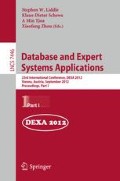Abstract
Correlated patterns are an important class of regularities that exist in a transactional database. CoMine uses pattern-growth technique to discover the complete set of correlated patterns that satisfy the user-defined minimum support and minimum all-confidence constraints. The technique involves compacting the database into FP-tree, and mining it recursively by building conditional pattern bases (CPB) for each item (or suffix pattern) in FP-tree. The CPB of the suffix pattern in CoMine represents the set of complete prefix paths in FP-tree co-occurring with itself. Thus, CoMine implicitly assumes that the suffix pattern can concatenate with all items in its prefix paths to generate correlated patterns of higher-order. It has been observed that such an assumption can cause performance problems in CoMine. This paper makes an effort to improve the performance of CoMine by introducing a novel concept known as items’ support intervals. The concept says that an item in FP-tree can generate correlated patterns of higher-order by concatenating with only those items in its prefix-paths that have supports within a specific interval. We call the proposed algorithm as CoMine++. Experimental results on various datasets show that CoMine++ can discover high correlated patterns effectively.
Access this chapter
Tax calculation will be finalised at checkout
Purchases are for personal use only
Preview
Unable to display preview. Download preview PDF.
References
Frequent itemset mining repository, http://fimi.cs.helsinki.fi/data/
Agrawal, R., Imieliński, T., Swami, A.: Mining association rules between sets of items in large databases. In: SIGMOD 1993, pp. 207–216. ACM (1993)
Agrawal, R., Srikant, R.: Fast algorithms for mining association rules in large databases. In: VLDB 1994, pp. 487–499 (1994)
Brin, S., Motwani, R., Silverstein, C.: Beyond market baskets: generalizing association rules to correlations. SIGMOD Rec. 26(2), 265–276 (1997)
Han, J., Cheng, H., Xin, D., Yan, X.: Frequent pattern mining: Current status and future directions. Data Mining and Knowledge Discovery 14(1) (2007)
Han, J., Pei, J., Yin, Y., Mao, R.: Mining frequent patterns without candidate generation: A frequent-pattern tree approach. Data Min. Knowl. Discov. 8(1), 53–87 (2004)
Kim, S., Barsky, M., Han, J.: Efficient Mining of Top Correlated Patterns Based on Null-Invariant Measures. In: Gunopulos, D., Hofmann, T., Malerba, D., Vazirgiannis, M. (eds.) ECML PKDD 2011, Part II. LNCS, vol. 6912, pp. 177–192. Springer, Heidelberg (2011)
Lee, Y.K., Kim, W.Y., Cai, D., Han, J.: Comine: efficient mining of correlated patterns, pp. 581–584 (November 2003)
Omiecinski, E.R.: Alternative interest measures for mining associations in databases. IEEE Trans. on Knowl. and Data Eng. 15(1), 57–69 (2003)
Sim, K., Phua, C., Yap, G., Biswas, J., Mokhtari, M.: Activity recognition using correlated pattern mining for people with dementia. In: Conf. Proc. IEEE Eng. Med. Biol. Soc. (2011)
Tan, P.-N., Kumar, V., Srivastava, J.: Selecting the right interestingness measure for association patterns. In: KDD 2002, pp. 32–41. ACM, New York (2002)
Wu, T., Chen, Y., Han, J.: Re-examination of interestingness measures in pattern mining: a unified framework. Data Min. Knowl. Discov. 21(3), 371–397 (2010)
Kim, W.-Y., Lee, Y.-K., Han, J.: CCMine: Efficient Mining of Confidence-Closed Correlated Patterns. In: Dai, H., Srikant, R., Zhang, C. (eds.) PAKDD 2004. LNCS (LNAI), vol. 3056, pp. 569–579. Springer, Heidelberg (2004)
Author information
Authors and Affiliations
Editor information
Editors and Affiliations
Rights and permissions
Copyright information
© 2012 Springer-Verlag Berlin Heidelberg
About this paper
Cite this paper
Uday Kiran, R., Kitsuregawa, M. (2012). Efficient Discovery of Correlated Patterns in Transactional Databases Using Items’ Support Intervals. In: Liddle, S.W., Schewe, KD., Tjoa, A.M., Zhou, X. (eds) Database and Expert Systems Applications. DEXA 2012. Lecture Notes in Computer Science, vol 7446. Springer, Berlin, Heidelberg. https://doi.org/10.1007/978-3-642-32600-4_18
Download citation
DOI: https://doi.org/10.1007/978-3-642-32600-4_18
Publisher Name: Springer, Berlin, Heidelberg
Print ISBN: 978-3-642-32599-1
Online ISBN: 978-3-642-32600-4
eBook Packages: Computer ScienceComputer Science (R0)

